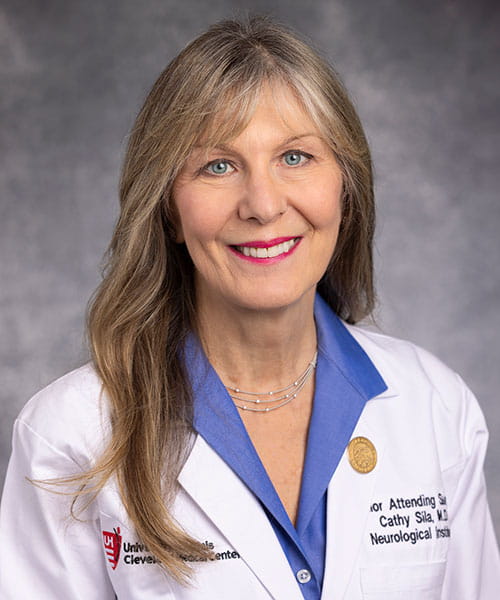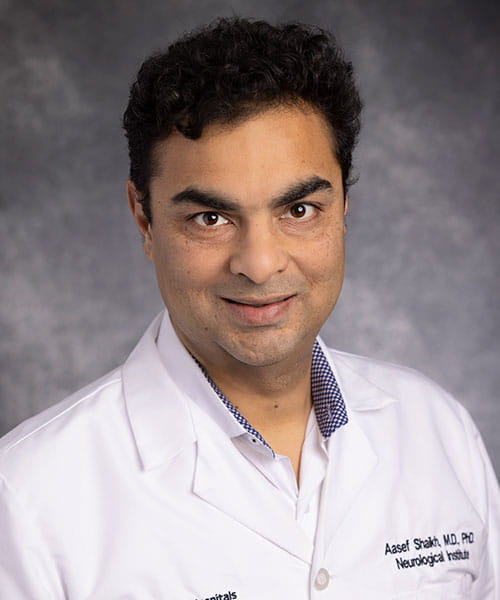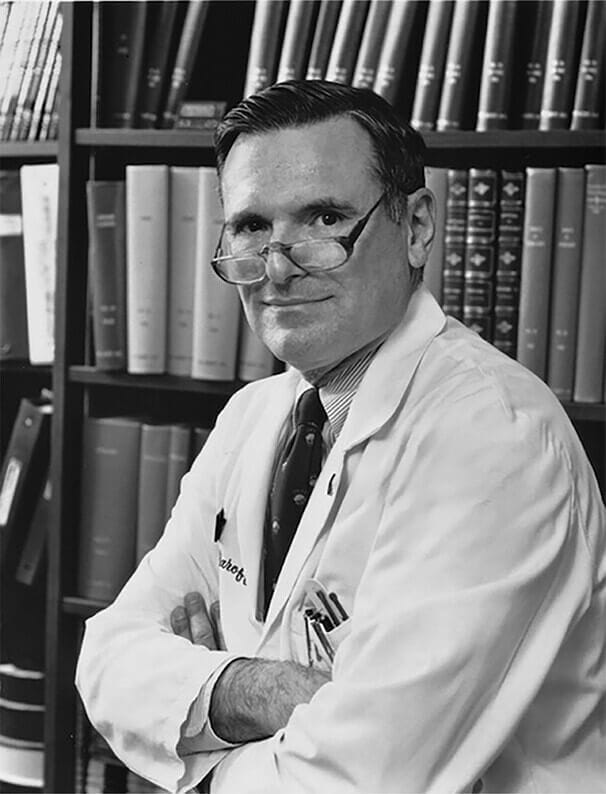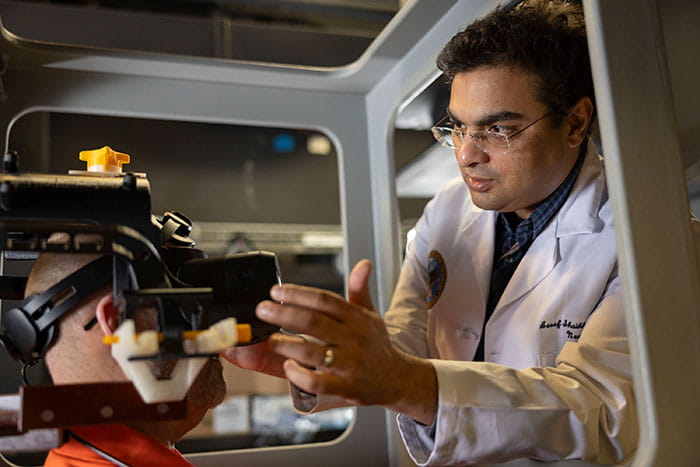Daroff Dell’Osso Lab’s Evolving Innovation Advances the Legacy of Dr. Robert Daroff
July 14, 2025
Innovations in Neurology & Neurosurgery | Summer 2025
Legendary neurologist and neuro-ophthalmologist Robert B. Daroff, MD, died on January 12, 2025. Among the countless accomplishments of his much-lauded career, Dr. Daroff was the founding Chair of the Department of Neurology at University Hospitals Cleveland Medical Center and Case Western Reserve University School of Medicine and a past President of the American Neurological Association.
 Cathy Sila, MD
Cathy Sila, MD Aasef G. Shaikh, MD, PhD
Aasef G. Shaikh, MD, PhD“Dr. Daroff’s reputation as a pioneering neurologist was already widely recognized when he succeeded Dr. Joseph Foley in 1980 as the next leader of our department,” says Cathy Sila, MD, the Gilbert W. Humphrey Endowed Chair in Neurology at University Hospitals. “During his 38 years on our faculty, Dr. Daroff’s passion for teaching endeared him to his students and colleagues and helped advance the next generation of academic leaders in neurology and neuro-ophthalmology.”
When Dr. Daroff arrived in Cleveland, he brought a robust research team and infrastructure that proved transformational in advancing the understanding of nystagmus and eye movement disorders, establishing what would become the Daroff Dell’Osso Lab in partnership with the Cleveland VA (now the Louis Stokes Cleveland VA Medical Center).
Today, The Lab’s mission continues under the leadership of Aasef G. Shaikh, MD, PhD, the Penni and Stephen Weinberg Chair in Brain Health and Vice Chair for Research within the University Hospitals Neurological Institute and Professor of Neurology at the School of Medicine.
Much of Dr. Daroff’s success stemmed from the collaboration he helped inspire between Cleveland’s wealth of neurological research institutions. In addition to the Cleveland VA and the world-class biomedical engineering department at Case Western Reserve University, Northeast Ohio is also home to the Cleveland Functional Electrical Stimulation (FES) Center, where Dr. Shaikh serves as Associate Medical Director.
“FES is one of the few Centers for Excellence funded by the federal government for rehabilitation research,” he says. “The center has over 75 principal investigators with a capacity for studying a number of niche areas, including Parkinson’s and other neurodegenerative disease, that is unparalleled.”
An Ever-evolving Focus
One of Dr. Daroff’s early partners at University Hospitals and the School of Medicine was R. John Leigh, MD. “Dr. Daroff and Dr. Leigh were among the first to focus on nystagmus and eye movement from a signal processing and engineering approach,” Dr. Shaikh says. “When I arrived, I continued their legacy, studying balance function in Parkinson’s and related movement disorders such as dystonia with an additional tool set from my training, which included neuromodulation with deep brain stimulation.”
 Robert B. Daroff, MD
Robert B. Daroff, MDA team of PhD students, postdoctoral fellows, medical students and undergraduates work alongside Dr. Shaikh with a focus on technology-driven neural engineering. One of their ongoing investigations involves how patients with Parkinson’s process visual signals to navigate through space.
“We are studying conflicting sensory information, so the patient’s vision says something, and the balance organ in the inner ear says something else,” Dr. Shaikh says. “Patients with Parkinson's tend to struggle with the conflict between sensory systems.”
The researchers are utilizing a flight-like motion simulator to generate various stimuli for patients to report their perceptions. Sophisticated psychophysics parameters are used to compare patients’ experiences with control subjects to identify the origin of perceptual challenges within the brain.
“Then we turn on the deep brain stimulators, implanted in the basal ganglia that serve as a switchboard or regulator of cerebral and cerebellar input and output,” Dr. Shaikh says. “By stimulating parts of that structure, we can observe changes to how patients perceive motion and use such information to develop computational models of what we call visuo-spatial navigation.”
Perhaps one of the most significant opportunities for collaboration within The Lab comes from discussions with patients. After one individual reported dizziness, curiosity led to a serendipitous project that has been underway for nearly a decade.
“We found that when we stimulate certain parts of the brain, some patients report experiencing double vision,” Dr. Shaikh says. “Historically, experts did not associate visual problems with Parkinson’s, but we now know that these individuals often have abnormal alignment of their eyes.”
He adds that approximately two-thirds of the Parkinson’s population experience some level of reading or visual problems, and one-third have frank double vision.
“Prior to this research, prisms or muscle surgeries were the only available treatments, but we showed that by using neurostimulation in the correct areas of the brain, we are able to treat double vision and squint in humans,” Dr. Shaikh says. “Our philosophy is to actively engage our patients in conversation and take seriously any symptoms they are experiencing — in my 25 years, I have witnessed a number of such occasions that have led to novel breakthroughs in the direction of research.”
A New Generation of Discovery
A new and exciting area of study within The Lab is visual navigation. “Unfortunately, patients with Parkinson’s tend to struggle with conflicting signals when searching for common objects that are moved within their environment,” Dr. Shaikh says. “Their top-down control within the brain’s cortex overrides reality.”
 Aasef G. Shaikh, MD, PhD works with a research participant in the flight simulator at the Daroff Dell’Osso Lab.
Aasef G. Shaikh, MD, PhD works with a research participant in the flight simulator at the Daroff Dell’Osso Lab.“This is a significant problem in Parkinson’s that could be the basis for visual hallucinations patients experience,” he says. “We are conducting visual search experiments while measuring eye movements as patients search for objects in environments with conflicting scenarios.” The team has found that deep brain stimulation near certain brain fibers projecting to midbrain and thalamus improves the behavior, which could form the basis for treatment in other complex neuropsychiatric conditions.
At University Hospitals, the School of Medicine and worldwide, an expanding network of investigation and novel therapy in neuro-ophthalmology and visual processing can be traced back to Dr. Daroff and the research community he shepherded for many decades.
University Hospitals and the School of Medicine share a rich history of producing academic powerhouses. Through the Daroff years and beyond, The Lab has trained more than 60 PhD students and postdocs who now hold research and clinical leadership positions at institutions around the world.
“I am the third-generation investigator in our lab, and our team members have enjoyed very productive academic careers because we do not stay in our silos,” Dr. Shaikh says. “We go out and talk to biomedical engineers, electrical engineers, hardware developers, ophthalmologists, visual psychophysics and neuropsychologists to look at one problem from multiple perspectives, which leads to very solid, rigorous research.”
For more information, contact Dr. Shaikh at axs848@case.edu.
Contributing Experts:
Aasef G. Shaikh, MD, PhD
Penni and Stephen Weinberg Chair in Brain Health
Vice Chair for Research
Department of Neurology
University Hospitals Neurological Institute
University Hospitals Cleveland Medical Center
Professor of Neurology
Case Western Reserve University School of Medicine
Director
National VA Parkinson Consortium Center
Associate Medical Director
Cleveland Functional Electrical Stimulation (FES) Center
Cathy Sila, MD
Chair, Department of Neurology
Gilbert W Humphrey Endowed Chair in Neurology
Inaugural Distinguished Senior Attending Physician
University Hospitals Neurological Institute
University Hospitals Cleveland Medical Center
Professor of Neurology
Case Western Reserve University School of Medicine


